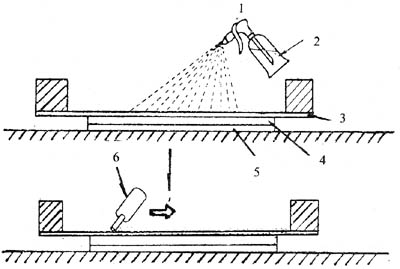a) Water paste method. One is to thoroughly clean the stretched wire mesh, remove the grease, dirt, and dust and dry it. Straight film film cut according to the required size, and coated photosensitive layer, at this time to confirm whether the film attached to the dust, when there is dust, it will produce pinholes and bad adhesion, and second, the back of the network toward The stencil is placed on a photosensitive film, and then thoroughly sprayed with a spray gun. The soft squeegee is then used to scrape the excess moisture.
Then the water inside the frame is removed with sponge or suede and dried (Figure 2-127). After drying, the film base is peeled off to obtain a shiny smooth photosensitive film on the web.

Figure 2-127 Water Method 1
1- Sprayer 2 - Water 3 - Screen 4 - Photosensitive Film 5 - Film Base 6 - Scraper

Figure 2-128 Water Method 2
1, 6 - Screen 2, 7 - Frame 3 - Photo Film 4 - Film 5 - Straight Film
The simpler method of operation is to thoroughly degreas the screen that has been stretched on the frame with a detergent and wash it with a spray head. Cut the straight film that is cut to the required size and attach it as shown in Figure 2-128. Use a scraper to remove excess water and dry it. In this way, the water attachment work can be performed while the screen is washed, and a photosensitive film with less dust and dirt can be obtained.
b) Photographic solution attachment method. It is a method of attaching a photo-sensitive liquid as a binder to a film. As with the above-mentioned water paste method, put a stretched screen frame on the top of the film and spread the photosensitive liquid from top to bottom, and push it forward like a print with a soft squeegee. If there is uneven phenomenon can also be repeated many times. After the coating is uniform, the remaining photosensitive liquid is removed with a small scraper or cloth and dried, as shown in Fig. 2-129. There are other two or three methods for emulsion attachment, and anyway, methods need to prevent bubbles.
c) Special application methods for pre-coated photosensitive sheets. Various film thickness pre-coated photosensitive sheets are available for sale on the market. With the same type of pre-coated photosensitive sheet can also be made of different film thickness. For example, after the above-mentioned sticking, the film is peeled off after being peeled off, and an arbitrary thickness of the photosensitive film can be obtained.

Figure 2-129 Photosensitive paste method
1-Scratch plate 2 - Photosensitive 3 - Photosensitive film 4 - Platform 5 - Film base 6 - Frame 7 - Wire mesh
c. Straight-line operation precautions.
Cut the photosensitive film to 50 to 70mm on each side of the net size. The film should be kept on a smooth glass plate, and it must be kept in a sanitary condition. The photosensitive film should be brushed gently with a brush, and the film should be placed facing down. When the film is manipulated, turn it over again.
When gluing, use a flannel to moisten the screen to form a uniform moisture or apply a latex and compound the film. Use a squeegee to scrape off excess moisture. If the film surface is white, it is a bubble. Come out, otherwise it will cause the omentum to stick loose and cause release.
After the film was placed, the screen plate was placed in a dark room and dried with a warm wind of about 30° C., and the film base was peeled off. After sufficiently drying, the film plate was able to fit closely with the positive plate film to perform exposure.
Rinse development is the same as the direct method. If the precise graphics do not appear, use a 5°C warm water spray. Be careful not to damage the layout.
The surface of the blown film is dried in warm winds, and the trimmed plate can be used after inspection.
Student Backpack,Business Backpack,Travel Backpack,Sport Backpack,Foldable Backpack,Laptop Backpack
Ningbo FonFON Industry&Trade Co.,Ltd , https://www.nbfonfon.com
